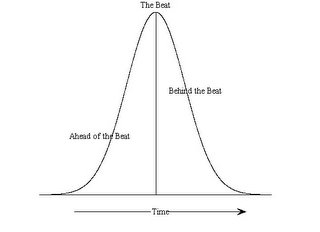I'm a book delivery person, thus I'm off today. It's also Valentine's Day. So of course I'm looking at blogs about jazz drumming. (?) And glad that Marisa can't get out of the driveway.
In any case, I should've asked sooner--I've been playing drums for 20 years--but I never totally understood the concept of playing "ahead" or "behind" the beat.
Or actually, after reading this, I realize it's exactly what I thought it meant, it's just that I usually veer off the subject when people wanna talk drums. I don't know why. I actually am quite the dunce when it comes to knowing anything about drums. I guess I always want them to be the mysterious, magical things that I introduced myself to in 1986.
This can hold me back sometimes.
In any case, I remember someone telling me at the Baystate or somewhere, how I play "behind the beat" and I was too embarassed to say "what does that mean?".
It'd be like George Bush asking a reporter "what DOES 'foreign policy' mean, actually?"
They meant it as a compliment.
In any case, yes, I guess that's what I do. Unless I'm over caffinated, I don't think you'll find me rushing the beat. Sometimes, time expands, and I can feel the one second it takes for a beat to go by as an infinite amount of time--like looking through a time microscope--and a tiny, human wavering of a bpm seems like the earth just changed its rotation.
Gah, I'm getting dry and boring. Dig this instead: it's from this blog
"A beat is not a fixed point in time; artists are humans, not mac
 hines. The beat is more like a Gaussian distribution with exactly "on the beat" being in the middle. For example, a drummer and bassist in a typical jazz trio might be playing exactly on the beat (the mode of the distribution). Playing ahead of the beat, the note falls to the left of center (i.e., it is played before the beat) with rapidly declining probability (since way to the left will lose the groove). This makes the piano part sound a little "pushed" but still in time. It brings the energy level up a bit. The more to the left of center you play, the more urgent the feel.
hines. The beat is more like a Gaussian distribution with exactly "on the beat" being in the middle. For example, a drummer and bassist in a typical jazz trio might be playing exactly on the beat (the mode of the distribution). Playing ahead of the beat, the note falls to the left of center (i.e., it is played before the beat) with rapidly declining probability (since way to the left will lose the groove). This makes the piano part sound a little "pushed" but still in time. It brings the energy level up a bit. The more to the left of center you play, the more urgent the feel.When playing behind the beat, the note falls to the right of center; i.e., a bit late. This makes the piano sound a bit more relaxed. This is, for example, a signature of Dr. John’s New Orleans style of playing. Dr. John (Mac Rebennack) started out as an electric bass player, where playing behind the beat makes the bass and kick drum lock in better, since the beater of the kick happens milliseconds before the bass note, so the end result is a percussive whump followed by the bloom of the bass note.
It’s all part of the innately human aspect of jazz. No good musician plays every note exactly on the beat. A typical drummer will keep the hats pretty much consistent, either on the beat or slightly ahead of the beat. Most kick drum parts are on the upbeat except when they want to emphasize a downbeat in which case that kick might be slightly ahead of the beat. The snare hits will often move from ahead to on to behind the beat depending on verse/chorus/fill, and so forth.
Playing along with drummers is the key to developing your own feel for things. Put on an old Police track - Stewart Copeland was almost always playing ahead of the beat. Now put on some old Al Green - Al Jackson Jr and Howard Grimes were almost always playing behind the beat (especially on the 2). Now put on the Stones' Honky Tonk Women - Keith Richards is always behind the beat and Charlie Watts is staying with him except for the kick drum, which ties it back to a solid beat every two bars.
It's not a science, but art. Or maybe its ... artsy science."

2 comments:
wow, i learned something today. cool!
What I never understood about such diagrams was if the crest of the wave was The Beat, what was the sound leading up to the beat (depicted by the rising left-hand side of the sine wave)? I've only learned recently that the valleys (troughs) between the wave crests are the relaxing, or rebounding, of the air molecules that have been compressed by the preceding beat (each beat -- or note, or, more simply, SOUND -- being themselves compressions of air molecules traveling from the point of origin through space until they are received and interpreted as sound. All this stuff is really really cool. Great post, Bri.
Post a Comment